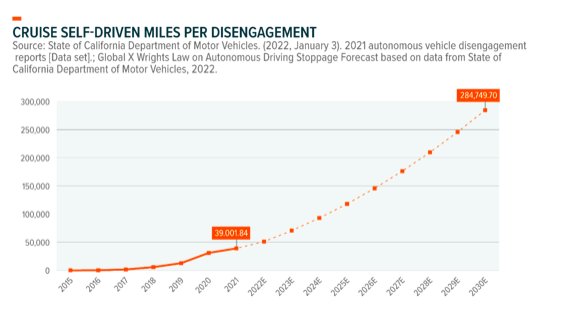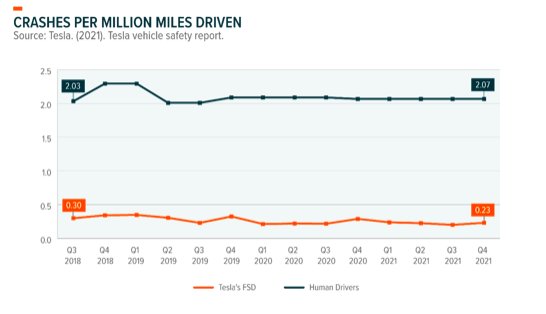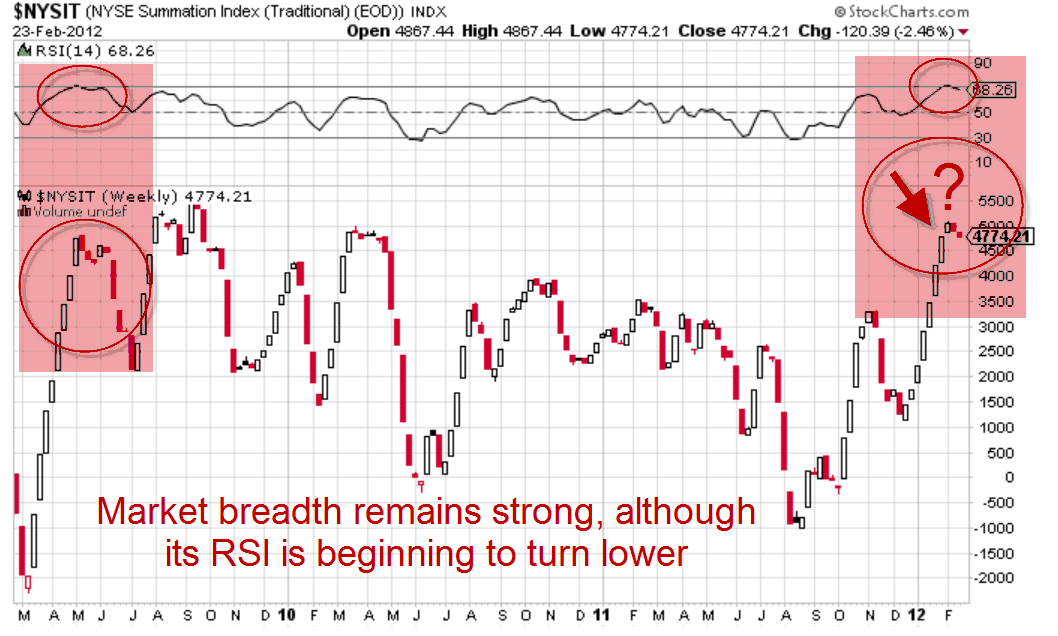By Laura Simeonova, Pedro Palandrani, research analysts at Global X ETFs
Autonomous Vehicle (AVs) technology has improved dramatically in recent years, supported by large investments by auto manufacturers, original equipment manufacturers (OEMs), and technology companies. Safety is one gauge of progress, and according to some analysis, AVs can reduce road fatalities by 94%.1
What makes this technology so intriguing is that with artificial intelligence (AI) and machine learning, AVs can improve on a safety metric like this the more miles they drive and the more data they collect.
The road to full autonomy and mass adoption remains a long-term proposition, due in part to necessary testing, as well as regulatory and infrastructure uncertainties. However, early commercial use cases with investment implications are already emerging.
Key Takeaways
- Stringent testing must be completed to demonstrate advanced AV technology is road ready. By one measure, about 275 million test miles are required for AVs to demonstrate human-like performance with 95% confidence.2
- Investments continue to pour into the AV supply chain, with some of the largest commitments coming from traditional auto manufacturers. Most of the largest carmakers plan to launch fully autonomous commercial vehicles by 2025.3,4,5
- Robotaxis are one of the more immediate growth opportunities for the AV industry, as they can be an easy, low-cost entry point for consumers. The total addressable market for robotaxis could be $160 billion by 2030.6 And a single robotaxi could earn between $30,000 and $85,000 per year.7,8
AV Tech Advances
Autonomous vehicle technology in the market today ranges between Levels 1 and 3, which incorporates various degrees of basic automation. Level 4 is considered high automation, as the car can control all driving functions and operate without human intervention under certain conditions.
As we wrote in The Future of Transportation Is Autonomous & Electric, in our opinion, Level 5 is the holy grail for AV technology because the vehicle requires no human input. Forecasts for when the first fully autonomous cars come to market remain a moving target.
Tesla first said it would happen in 2019, and then changed it to 2021, before pushing it to 2022.9 Nissan, Renault, and Toyota believed that they would have Level 5 cars by 2020. Others, such as Jaguar Land Rover and Mercedes Benz, say 2024 and 2025, respectively.10 GM says they will sell fully autonomous vehicles by “the middle of the decade.”11
Big Strides
But even though fully autonomous cars haven’t hit the roads yet, the technology has made significant strides. AVs constantly collect and process billions of data points from an array of cameras with sensors, radar, and LiDar systems, which are much improved and more affordable than earlier iterations.
Also, advanced driver-assistance systems (ADAS), including adaptive cruise control and self-parking systems, are now increasingly available in low to mid-range models and not just high-end models.
AVs use the data that they collect to continually improve the AV network’s driving skills and reduce the instances of software disengagement events and accidents. GM’s Cruise can drive 39,002 miles before triggering a disengagement event, which requires the driver or operator to manually take control of the vehicle.12 At current learning rates, by 2030, GM’s AV technology could drive close to 300,000 miles before triggering a disengagement.13

Safety Data
Another way to measure the progress of AVs is by looking at the number of crashes. Tesla’s Full Self Driving (FSD) autonomous vehicle technology is involved in accidents at a rate 10x less than human drivers.14

On the connectivity side, companies debate whether they should deploy dedicated short-range communications (DSRC) or cellular vehicle-to-everything (C-V2X) systems for vehicle-to-everything (V2X) communication.15,16 C-V2X, which first emerged in 2017, is considered better because it can more easily incorporate future 5G-enabled technologies, but DSRC is still more widely deployed.17
Both technologies require good network coverage or dedicated spectrum, which is not always available.
On the software side, object analysis and detection remain a challenge for AVs in certain scenarios, such as when it’s dark or the road surface is unusual, like gravel or cobblestone. Decision-making is another challenge to overcome.
Hybrid Approach
Currently, most companies take a hybrid approach using neural networks and rule-based programming to mimic human decision-making.18 With rule-based decision-making engineers require significant time and effort to account for every possible scenario, while just using neural networks can make it difficult to backtrack the root causes of certain decisions.19 Using a hybrid approach can resolve some of these issues.
AV safety and operational testing of all this technology is critical. To demonstrate human-like performance that makes them fit for the road, AVs would need to drive about 275 million miles.20 And to drive 275 million miles to collect the required data, it would take 100 AVs driving 24 hours a day, 365 days a year, at an average speed of 25 miles per hour for more than 10 years.21,22
However, testing times can be reduced by combining real-world tests with “model-in-the-loop simulations.” These simulations consist of running vehicles through algorithms that cover every possible scenario to ensure that the AV system can make the right decisions.23
Investment Shift
Traditional carmakers continue to show their commitment to the self-driving space. GM announced a $27 billion investment in electric and autonomous vehicles through 2025. Ford followed with a $29 billion investment in EVs and AVs, $7 billion of which is for self-driving technology.24 Audi said that it has plans to spend close to $16 billion on self-driving and sustainable technology by 2023.25
To read this article in its entirety, please click here and visit the Global X blog.
Photo Credit: Gamaliel Cabana via Flickr Creative Commons
FOOTNOTES
1. U.S. Department of Transportation. (2017, September). Automated driving systems 2.0: A vision for safety [DOT HS 812 442]. National Highway Traffic Safety Administration.
2. Kalra, N., & Paddock, S. M. (2016). Driving to safety: How many miles of driving would it take to demonstrate autonomous vehicle reliability? Rand Corporation.
3. Olinga, L. (2022, January 27). Elon Musk promises full self-driving Teslas in 2022. The Street.
4. Haining, C. (2020, March 24). Self-driving cars: All you need to know. Carbuyer.
5. Korosec, K. (2022, January 5). GM aims to sell personal autonomous vehicles by mid decade. TechCrunch.
6. Intel. (2019, November 5). Mobileye outlines strategy for driving significant growth [Press release].
7. Tesla. (2019, April 22). Tesla autonomy day [Video]. YouTube.
8. Bohlsen, M. (2020, October 11). Who will win the lucrative autonomous vehicles (robotaxis) race? Seeking Alpha.
9. Olinga, L. (2022, January 27). Elon Musk promises full self-driving Teslas in 2022. The Street.
10. Haining, C. (2020, March 24). Self-driving cars: All you need to know. Carbuyer.
11. Korosec, K. (2022, January 5). GM aims to sell personal autonomous vehicles by mid decade. TechCrunch.
12. Global X Analysis of data derived from: State of California Department of Motor Vehicles. (2022, January 3). 2021 autonomous vehicle disengagement reports [Data set].
13. Ibid.
14. Tesla. (2021). Tesla vehicle safety report.
15. Duvall, T., Hannon, E., Katseff, J., Safran, B., & Wallace, T. (2019, May 22). A new look at autonomous-vehicle infrastructure. McKinsey & Company.
16. Canis, B. (2021, April 23). Issues in autonomous vehicle testing and deployment (CRS Report No. R45985).
17. Ibid.
18. Heineke, K., Kampshoff, P., Mkrtchyan, A., & Shao, E. (2017, May 22). Self-driving car technology: When will the robots hit the road? McKinsey & Company.
19. Ibid.
20. Ibid.
21. Ibid.
22. Kalra, N., & Paddock, S. M. (2016). Driving to safety: How many miles of driving would it take to demonstrate autonomous vehicle reliability? Rand Corporation.
23. Heineke, K., Kampshoff, P., Mkrtchyan, A., & Shao, E. (2017, May 22). Self-driving car technology: When will the robots hit the road? McKinsey & Company.
24. Dent, S. (2021, February 5). Ford commits $29 billion to electric and autonomous vehicle development. Engadget.
25. Research Briefs. (2020, December 16). 40+ corporations working on autonomous vehicles. CB Insights.
Disclosure
Investing involves risk, including the possible loss of principal. Additional risks include, but not limited to, rapid changes in technology, intense competition, rapid obsolescence of products and services, loss of intellectual property protections, evolving industry standards and frequent new product productions, and changes in business cycles and government regulation. International investments may involve risk of capital loss from unfavorable fluctuation in currency values, from differences in generally accepted accounting principles, or from economic or political instability in other nations. Emerging markets involve heightened risks related to the same factors as well as increased volatility and lower trading volume. Securities focusing on a single country and narrowly focused investments may be subject to higher volatility. The Global X International Access Suite Funds are non-diversified.



